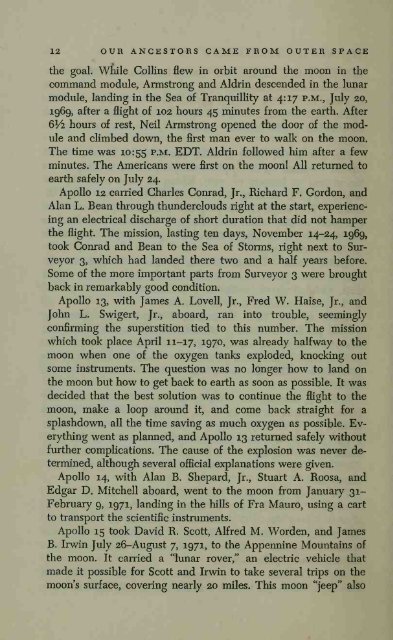You also want an ePaper? Increase the reach of your titles
YUMPU automatically turns print PDFs into web optimized ePapers that Google loves.
12 OUR ANCESTORS CAME FROM OUTER SPACE<br />
the goal. While Collins flew in orbit around the moon in the<br />
command module, Armstrong and Aldrin descended in the lunar<br />
module, landing in the Sea of Tranquillity at 4:17 p.m., July 20,<br />
1969, after a flight of 102 hours 45 minutes from the earth. After<br />
6V2 hours of rest, Neil Armstrong opened the door of the module<br />
and climbed down, the first man ever to walk on the moon.<br />
The time was 10:55 p.m. EDT. Aldrin followed him after a few<br />
minutes. The Americans were first on the moon! All returned to<br />
earth safely on July 24.<br />
Apollo 12 carried Charles Conrad, Jr., Richard F. Gordon, and<br />
Alan L. Bean through thunderclouds right at the start, experiencing<br />
an electrical discharge of short duration that did not hamper<br />
the flight. The mission, lasting ten days, November 14-24, 1969,<br />
took Conrad and Bean to the Sea of Storms, right next to<br />
Surveyor<br />
3, which had landed there two and a half years before.<br />
Some of the more important parts from Surveyor 3 were brought<br />
back in remarkably good condition.<br />
Apollo 13, with James A. Lovell, Jr., Fred W. Haise, Jr., and<br />
John L. Swigert, Jr., aboard, ran into trouble, seemingly<br />
confirming the superstition tied to this number. The mission<br />
which took place April 11-17, 1970, was already halfway to the<br />
moon when one of the oxygen tanks exploded, knocking out<br />
some instruments. The question was no longer how to land on<br />
the moon but how to get back to earth as soon as possible. It was<br />
decided that the best solution was to continue the flight to the<br />
moon, make a loop around it, and come back straight for a<br />
splashdown, all the time saving as much oxygen as possible. Everything<br />
went as planned, and Apollo 13 returned safely without<br />
further complications. The cause of the explosion was never determined,<br />
although several official explanations were given.<br />
Apollo 14, with Alan B. Shepard, Jr., Stuart A. Roosa, and<br />
Edgar D. Mitchell aboard, went to the moon from January 31-<br />
February 9, 1971, landing in the hills of Fra Mauro, using a cart<br />
to transport the scientific instruments.<br />
Apollo 15 took David R. Scott, Alfred M. Worden, and James<br />
B. Irwin July 26-August 7, 1971, to the Appennine Mountains of<br />
the moon. It carried a "lunar rover," an electric vehicle that<br />
made it possible for Scott and Irwin to take several trips on the<br />
moon's surface, covering nearly 20 miles. This moon "jeep" also

















